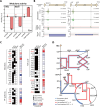Unveiling the novel regulatory roles of RpoD-family sigma factors in Salmonella Typhimurium heat shock response through systems biology approaches
- PMID: 39471211
- PMCID: PMC11548764
- DOI: 10.1371/journal.pgen.1011464
Unveiling the novel regulatory roles of RpoD-family sigma factors in Salmonella Typhimurium heat shock response through systems biology approaches
Abstract
Three RpoD-family sigma factors, RpoD, RpoS, and RpoH, play critical roles in transcriptional regulation in Salmonella enterica serovar Typhimurium under heat shock conditions. However, the genome-wide regulatory mechanisms of these sigma factors in response to heat stress have remained elusive. In this study, we comprehensively identified 2,319, 2,226, and 213 genome-wide binding sites for RpoD, RpoS, and RpoH, respectively, under sublethal heat shock conditions (42°C). Machine learning-based transcriptome analysis was employed to infer the relative activity of iModulons, providing valuable insights into the transcriptional impact of heat shock. Integrative data analysis enabled the reconstruction of the transcriptional regulatory network of sigma factors, revealing how they modulate gene expression to adapt to heat stress, including responses to anaerobic and oxidative stresses. Notably, we observed a significant expansion of the RpoS sigmulon from 97 to 301 genes in response to heat shock, underscoring the crucial role of RpoS in regulating various metabolic processes. Moreover, we uncovered a competition mechanism between RpoD and RpoS within RpoS sigmulons, where RpoS significantly increases its binding within promoter regions shared with RpoD under heat shock conditions. These findings illuminate how three RpoD-family sigma factors coordinate multiple cellular processes to orchestrate the overall response of S. Typhimurium to heat stress.
Copyright: © 2024 Park et al. This is an open access article distributed under the terms of the Creative Commons Attribution License, which permits unrestricted use, distribution, and reproduction in any medium, provided the original author and source are credited.
Conflict of interest statement
The authors have declared that no competing interests exist.
Figures







Similar articles
-
Role of RpoS in Regulating Stationary Phase Salmonella Typhimurium Pathogenesis-Related Stress Responses under Physiological Low Fluid Shear Force Conditions.mSphere. 2022 Aug 31;7(4):e0021022. doi: 10.1128/msphere.00210-22. Epub 2022 Aug 1. mSphere. 2022. PMID: 35913142 Free PMC article.
-
Identification of RpoS (sigma(S))-regulated genes in Salmonella enterica serovar typhimurium.J Bacteriol. 2000 Oct;182(20):5749-56. doi: 10.1128/JB.182.20.5749-5756.2000. J Bacteriol. 2000. PMID: 11004173 Free PMC article.
-
Crl binds to domain 2 of σ(S) and confers a competitive advantage on a natural rpoS mutant of Salmonella enterica serovar Typhi.J Bacteriol. 2010 Dec;192(24):6401-10. doi: 10.1128/JB.00801-10. Epub 2010 Oct 8. J Bacteriol. 2010. PMID: 20935100 Free PMC article.
-
Recent insights into the general stress response regulatory network in Escherichia coli.J Mol Microbiol Biotechnol. 2002 May;4(3):341-6. J Mol Microbiol Biotechnol. 2002. PMID: 11931567 Review.
-
Recent advances in the characterization of Crl, the unconventional activator of the stress sigma factor σS/RpoS.Biomol Concepts. 2016 Jun 1;7(3):197-204. doi: 10.1515/bmc-2016-0006. Biomol Concepts. 2016. PMID: 27180360 Review.
Cited by
-
Cold stress enhances cryotolerance in Lacticaseibacillus rhamnosus B6 via membrane lipid remodeling and differential protein expression.Curr Res Microb Sci. 2025 Aug 5;9:100453. doi: 10.1016/j.crmicr.2025.100453. eCollection 2025. Curr Res Microb Sci. 2025. PMID: 40837524 Free PMC article.
-
Bacterial allies in chromium hyperaccumulation: native rhizobacterial dynamics of profusely growing Dactyloctenium aegyptium in highly tainted tannery sludge.World J Microbiol Biotechnol. 2025 Aug 26;41(9):314. doi: 10.1007/s11274-025-04528-y. World J Microbiol Biotechnol. 2025. PMID: 40856764
References
-
- D’Aoust J, Doyle M. Foodborne bacterial pathogens. Marel Dekker Inc, New York, New York. 1989.
MeSH terms
Substances
LinkOut - more resources
Full Text Sources

